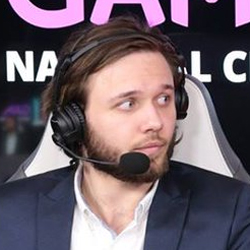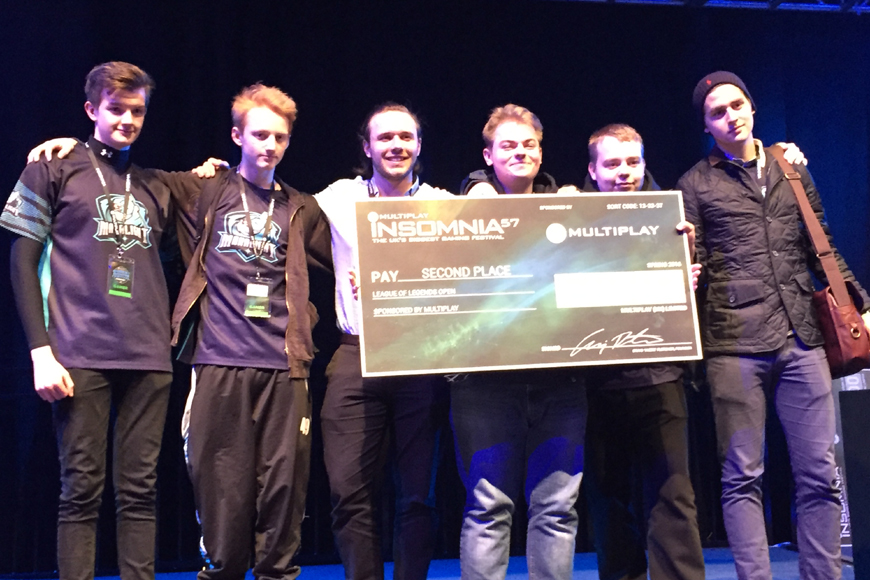It’s not easy to form a competitive League of Legends team – you need to consider player roles, team dynamics, leadership, shotcalling and more.
In this article, former ManaLight head coach Will “Frozen Dawn” Burgess (pictured with the team, third from left) offers advice to coaches, managers and players who are looking to build a team, with tips predominantly focusing around player synergies and strategy rather than the admin side of an organisation.
1. Identify the core
The core of the team usually consists of two or three players who influence how the team functions in game – and typically dictate the team’s playstyle.
Understanding your team’s core and how it interacts with the team as a whole is vital when building strategies and developing the team’s playstyle. An example core might be a mid-laner how is very good at pushing leads and playing aggressively, combined with a jungler who focuses all of their pressure around the mid lane.
Another example could be having the two solo laners consistently roaming between the lanes to each other, in order to gank and help take down towers. In this instance, the top and mid laners act as the core of the team. The idea behind the core is that it does not change much during the metas; the playstyles are generally very similar and are obviously well synergised.
It is not merely having two laners who are both aggressive and enjoy roaming, but rather having two players that work well together, as a unit, to help define the team’s playstyle.
“Understanding your team’s core and how it interacts with the team as a whole is vital when building strategies and developing the team’s playstyle.”
One will find that the nature of the core can vary between teams massively, and you can quite easily find them in the pro-LCS teams for example. For example, Bjergsen and Santorin were the old core of TSM.
The core is typically played around with and is the main reason for wins/losses. If whatever the core does is successful, then the team probably wins. If the core fails, then the team often loses.
Identifying a core can be quite difficult; usually during trials you are looking for players who aim to do similar things. For example, a jungler that’s inclined towards pressuring mid and a mid laner who naturally plays aggressively. You can see this can become the team’s core if you develop it.
Alternatively, you might have a super aggressive bot lane and a mid laner who loves roaming bot. If you notice this in trials, you might want to look to establish this as the core of the team. There are a huge number of possibilities for the team’s core.
2. Build the outer layers
Once you have established your core, you need to build upon the outer layers. The outer layers are the other players in the team that, when added to the core, provide the entire team dynamic.
If your core is your mid-laner and jungler, then the outer layers are your top lane and bottom lane. What is essential for your outer layers is that they work with the strengths of the core and help eliminate the weaknesses of the core.
So let’s imagine your core is a jungler who works around mid lane, and a mid-laner who plays very agro. An example of good outer layers in this scenario would be a top laner who is extremely passive and can hold their own without much pressure from the jungler, and a bot lane that can do the same, with a support who also prefers to roam and pressure mid.
Naturally, this type of team will look to hold top and bot whilst snowballing mid with jungler and support pressure. This will be their playstyle for the beginning. Of course, it is somewhat champion dependent and meta dependent – it can be developed and changed. But in essence that is how they will win games.
“When building a team, you always have to consider who will lead the players in-game. Overlooking this in favour of a slightly more synergised team dynamic can be very damning.”
From here, the team can look to develop strategies and draft around the knowledge of their playstyle. This might remind you somewhat of TSM at Worlds. The mid-laner and jungler would look to snowball, whilst bot holds and top falls behind. However, the top-laner would, based on the champions he played, try to remain relevant. The team recognised its core as mid-lane and jungle presence – and aimed to play almost every game with that in mind.
The job of a coach is to figure out the team’s core, plan the roles of the outer layers and make sure the team develops in a way that fits the playstyle of the team as a whole. What you don’t want to do is play in a way that goes against the core. For example, if your core is a mid-laner and jungler being aggressive, you won’t really want a top-laner and a bot lane that demand pressure from the jungler.
And you do not want to be playing passive utility mids. By this, I mean that it’s not optimal to your team’s dynamic. Obviously, there are times where you may want to do this to throw opponents off; having more than one playstyle is important.
3. Ascertain shotcalling and leadership
Although this topic could be an entire article in itself, I want to touch on how shotcalling and leadership work with regard to the core and outer layers.
It is not essential, in any way, for your core to include the shotcaller. But it is of course essential that your shotcaller understands the team dynamic.
When building a team, you always have to consider who will lead the players in-game. Overlooking this in favour of a slightly more synergised team dynamic can be very damning. In addition, just because you built around the core does not make them the more valuable players for the team. Team building isn’t about suggesting one player is better than the others – it’s merely a strategic decision to help your team win more games.
Make sure that everybody knows and is on board with the team dynamic, otherwise some people may feel unimportant, useless, or not even part of the team. With regard to the old TSM team, Dyrus was on board with the dynamic of him being left alone, but he still took a huge amount of community slack.
Within the team dynamic, everyone has a job to do. Like a chain, the team will only ever be as strong as its weakest link. But this strength doesn’t come in one’s ability to carry, but in one’s ability to meet the win conditions of the team dynamic – and to do their job within the team.
“Make sure that everybody knows and is on board with the team dynamic, otherwise some people may feel unimportant, useless, or not even part of the team.”

Will “Frozen Dawn” Burgess is a League of Legends coach who led former UK eSports organisation ManaLight to second place in the 2016 ESL UK Premiership Spring Season and at Insomnia57.

Dom is an award-winning writer and finalist of the Esports Journalist of the Year 2023 award. He has almost two decades of experience in journalism, and left Esports News UK in June 2025.
As a long-time gamer having first picked up the NES controller in the late ’80s, he has written for a range of publications including GamesTM, Nintendo Official Magazine, industry publication MCV and others. He also previously worked as head of content for the British Esports Federation.


